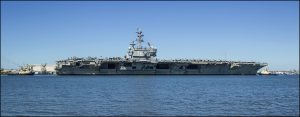The United States Navy unveiled its long-term shipbuilding plan on December 10 in a report to the U.S. Congress. Spanning 30 years, from financial year 2022 to 2051, it “is consistent with the National Defense Strategy (NDS) which recognizes China and Russia as near peer threats,” the U.S. Deputy Secretary of Defense David L. Norquist noted in a statement. “The plan calls for a larger fleet of both manned and unmanned vessels prepared to face greater challenges on, above, or under the sea by accelerating submarine construction, modernizing aircraft, extending the service life of cruisers, and increasing the number of destroyers,” it added.
The plan is based on a recently completed Future Naval Force Study (FNFS) carried out by the navy, Joint Chiefs of Staff, and the Office of the Secretary of Defense’s Cost Assessment and Program Evaluation. According to the report to Congress, the goal of the FNFS was “to provide comparative analytic assessments of naval force structure options designed to maximize maritime dominance in the era of great power competition, consistent with the National Defense Strategy (NDS) and upcoming Tri-Service Maritime Strategy.” The FNFS examined risks and benefits attached to three alternative future fleet architectures, leading to the 30-year shipbuilding plan, the report added.
According to the shipbuilding plan, the navy seeks to procure 130 ships between FY 2022 and FY 2030, including a nuclear-powered aircraft carrier. It notes that per the plan the navy will be able to acquire 355 ships between FY 2031-33. According to the plan, the U.S. Navy will have a total battle force of 546 ships, including unmanned surface and subsurface vessels, in FY 2045. (The U.S. Navy currently has 296 platforms in its inventory.) As if to assuage concerns that all of this is a bit too much, the statement notes, “although we reach 355 ships by the early 2030s, the plan is about more than numbers of ships. It is about equipping our future force for the enduring defense of our nation.”
In October, then-Secretary of Defense Mark Esper unveiled a plan to develop Battle Force 2045 with a targeted U.S. naval fleet strength of more than 500 ships by that year, at an online event organized by Center for Strategic and Budgetary Assessments. However, at that event he also noted the inherent difficulties associated with such an ambitious plan; USNI quoted Esper as saying “Achieving Battle Force 2045 over the long run will not be easy. Parochial interests, budget uncertainties, industrial capacity, and other competing factors will contest our ambitions.”
Some of the complications that Esper brought up were also recently reiterated by Chairman of the Joints Chiefs of Staff General Mark Milley. In a speech on December 3, Milley said of this serious push towards acquiring naval, air and space-centric assets: “It’s a very, very difficult exercise we’re going to have to go through. It’s going to be ruthless, there’s going to be a lot of bloodletting and a lot of stuff left on the floor.” Multiple reports suggest that the Pentagon is seeking to take money away from the army and the air force and allocate it for the ambitious shipbuilding plan – something that will, predictably, lead to a fair bit of inter-service bureaucratic fights.
But some naval analysts maintain that, fundamentally, the plan to dramatically grow the U.S. navy in size makes strategic sense given the emerging threat environment in the Indo-Pacific. In a recent interview to The Diplomat, National Defense University professor Geoffrey Gresh noted that Esper and Milley were “right to view the rising importance of the navy in an age of great power competition.” Gresh however also added that along with such efforts and reposturing of forces across theaters, the U.S. should continue to work with allies and partners in meeting challenges in maritime Eurasia.
The Pentagon’s 2020 China military power report released in September noted that at the present, the People’s Liberation Army Navy is the biggest in the world with a fleet of approximately 350 surface vessels and submarines.

































